
Types of Solar Energy Systems in Maine
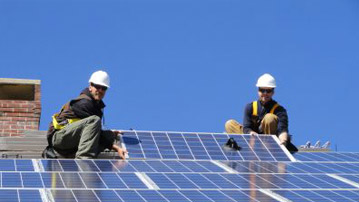
Solar systems without batteries
These systems generate solar electricity which is used to power your home. If more power is needed, such as during the night, electricity is drawn from the utility grid. If your residential solar power system produces more energy than needed, the excess is fed back into the power grid, and you are credited for future use under net metering.
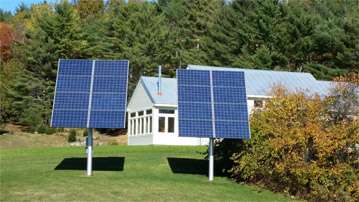
Solar systems with battery backup
Do you need emergency power during grid outages? These solar PV systems are connected to the utility grid and include a solar battery bank that is charged by your solar panels. In the event of a power outage in Maine, the solar battery backup system would continue to supply your house or business with power. Sundog Solar experts can work with you to determine critical power loads for your solar electricity during power outages.
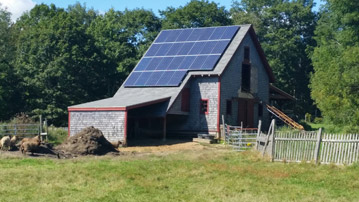
Off-grid solar energy systems
These are great for Maine homes that are too far from the power grid to be economically connected or for someone who has declared energy independence and chooses not to be connected to the grid. These systems charge solar batteries which are used to power the home. They help eliminate or reduce the need for a noisy generator.
Sundog Solar – Maine’s Local Solar Panel Installers
We provide high-quality design, installation, and repair services for solar energy systems throughout Maine.
First, we listen to your renewable energy needs as a customer and homeowner. Then, we design a solar energy system that meets your goals and budget. We also focus on conservation and efficiency measures that can help reduce your electricity loads.
Finally, our team of certified and insured solar technicians installs your system. Our solar installers are known throughout Maine for being friendly, professional, and knowledgeable. We take safety seriously and are dedicated to high-quality workmanship.
Sundog Solar installs systems throughout Maine, including Freeport, Rockland, Augusta, Bangor, Bar Harbor, Ellsworth, and Blue Hill. We are a locally-owned solar company dedicated to paying a living wage.
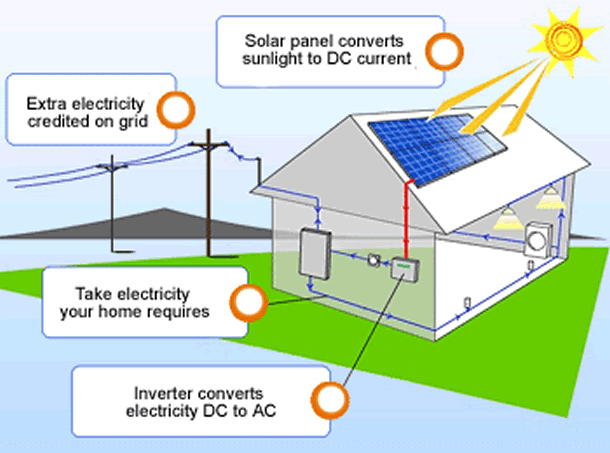
-Teresa, Searsmont, Maine
Solar 101
How Does Solar Power Work?
Photovoltaic (PV) technology transforms sunlight into clean energy. To use this technology for your home or business, you need a basic renewable energy system comprised of the following:
- Solar panels, which generate DC (direct current) electricity
- A solar inverter, which changes DC to AC (alternating current) power. AC power is the electricity used in most homes and businesses
- The DC current in each of the cells is combined into one central circuit. DC power can be used in many mobile applications such as in an RV, boat, or to charge solar system batteries.
Houses and businesses use alternating current (AC) electricity. Once the power is converted by the inverter, it can then be used by appliances, lights, and electrical devices.
With these basic components, you can generate electricity and feed it to your household circuits as well as send any excess electricity you make back to the grid for full retail credit. Under net metering in Maine, solar homes receive credits on their CMP or Versant Power bills.
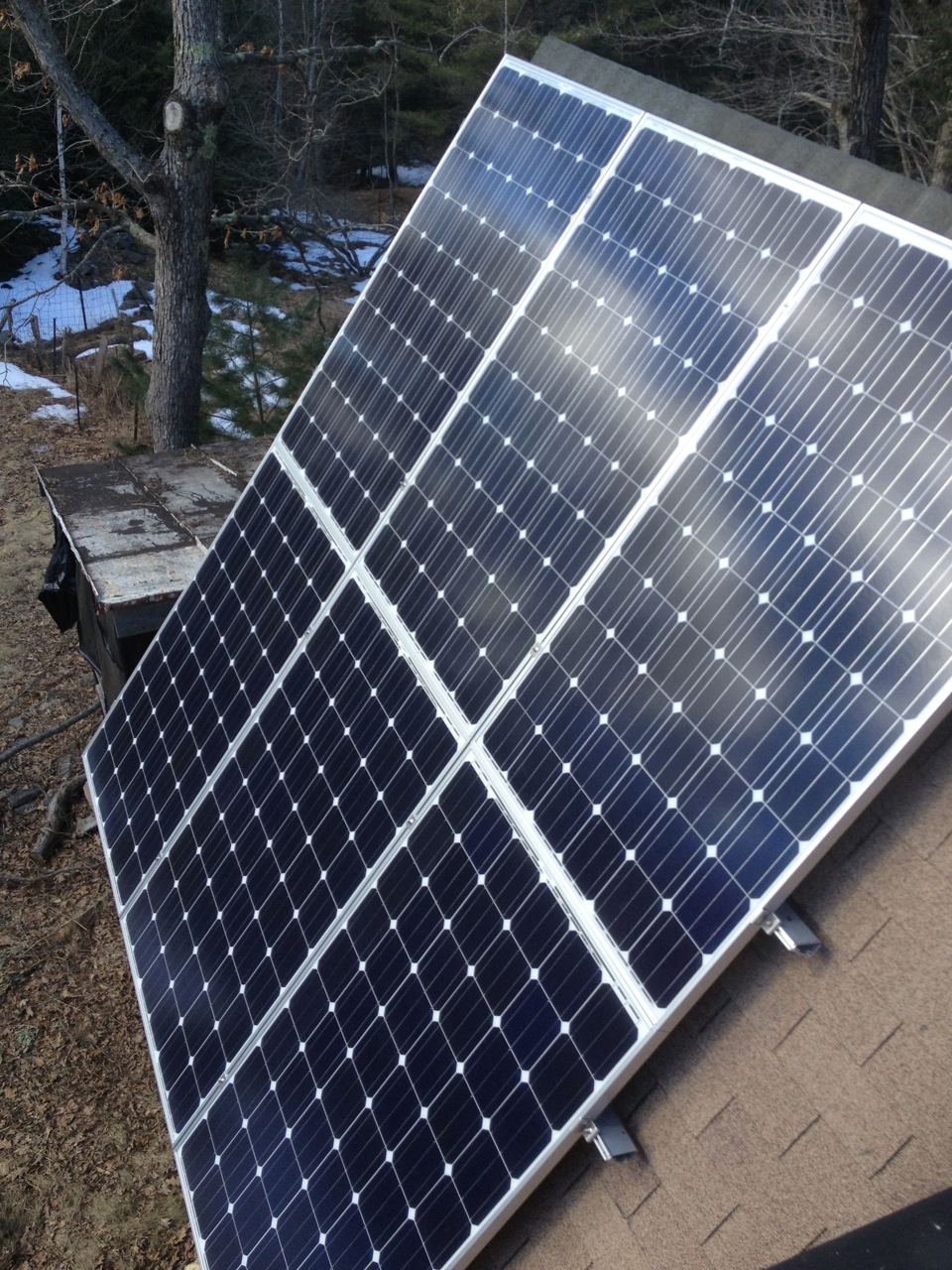
Maine has the best solar energy resource in New England!
Energy independence is on everyone’s mind these days. With the unpredictable cost of fuel fuels, an unreliable electric grid, and economic concerns, it makes sense to create a renewable energy strategy that provides a brighter, more secure future. Boosting solar system installation and deployment is a major goal of Maine Governor Janet Mills, as concern mounts about climate change.
Solar technology has been proven over many decades, and today it’s more affordable than ever! We use proven solar panels and inverters with excellent warranties to protect your investment.
1,000 Watts Per Square Meter
That’s how much of the sun’s power strikes the earth every hour. Maine receives a yearly average of 4 hours of sun each day. When you consider that Germany averages 3.5 hours of sunlight each day and that they are the world leaders in solar panel installations, Maine is perfect for solar energy!
Frequently Asked Questions
Should I install solar panels in Maine?
What are the benefits of installing a solar system in Maine?
Many people want to reduce their reliance on fossil fuels and achieve greater energy independence. Installing a solar energy system on your property is a great way to take advantage of the free energy that is falling on your property every day.
Solar energy is a safe, low-risk investment. Sundog Solar uses quality equipment with long warranties to protect your investment. Our solar systems typically pay for themselves through savings in less than ten years, yet reliably produce clean energy for 30 years. As power rates increase, the value of the savings increases.
The federal tax credit reduces the net cost of a solar panel system by 26%. This valuable incentive will expire at the end of 2022, making now a great time to go solar! Businesses can also take advantage of accelerated depreciation or bonus depreciation.
What is solar net metering?
Solar energy customers that are connected to the power grid can be credited for the surplus solar electricity that they feed to the power grid. This is called net metering or net energy metering and it is must adhere to Maine Public Utility Commission (PUC) rules.
Many solar households generate more solar electricity than they consume on sunny days. If the system doesn’t have batteries, any surplus electricity goes to the power grid and you will receive credits on your electric bill. If you supply 5 kWh of electricity to the grid during a sunny day, then you use 5 kWh of electricity at night, then you will owe no money for the nighttime power that you consumed.
Unfortunately, these credits expire after one year, so proper solar system sizing is important in maximizing the value of your system from your investment. Sundog Solar is skilled in sizing solar systems and uses your energy usage history for the most accurate solar system sizing possible.
Many Sundog Solar customers pay only the monthly connection fee to the electric company. Such homes are net zero which means that the solar panels generate all the electricity the household consumes over the course of a year.
How do I take advantage of net metering with my solar panel system?
When Sundog Solar installs a solar system, we also apply for interconnection with your utility provider (Central Maine Power, Versant Power, etc). Sundog Solar pays the interconnection fee as part of our installation service. Our goal is to make the process simple and easy for our customers by taking care of these crucial details.
Will solar panels boost my home property value?
Installing a solar energy system on your house can significantly increase your home’s value. Solar houses are cheaper to operate because the electric bills are dramatically lower. In fact, under net metering, many Sundog Solar customers pay only the delivery fee that is required by all electric utility customers and do not pay for grid power consumption.
A study by the Lawrence Berkeley National Lab titled “Selling into the sun: Price premium analysis of a multi-state dataset of solar homes“ found that solar homes sell for far more than homes without solar energy systems. Home buyers are willing to pay a premium for homes with solar PV systems.
Most of the solar systems that we install are less than $3 per watt. On average, solar houses sell for $3 more per watt of installed solar energy capacity. A home with a 5,000 W (5 kW) system would, therefore, sell for roughly $15,000 more than a comparable home without solar energy.
How does using solar energy benefit the environment?
There is now indisputable evidence that human activities are a major factor in changing our climate. The electric power industry is one of the top producers of greenhouse gases globally due to its reliance on coal, natural gas, and petroleum. In Maine, a lot of power is generated by burning fossil fuels. The State of Maine is actively encouraging residents and business owners to utilize solar energy.
Home and business owners have a choice in where their power comes from and using solar energy combined with energy efficiency improvements is a great way to dramatically reduce our greenhouse gas emissions. Unless we collectively take action to switch to clean energy sources, climate change will continue unmitigated and may surpass a tipping point. Sundog Solar was founded to help make solar energy available and affordable throughout Maine.
How much money can I save on my power bill if I install solar panels?
The cost savings from installing a solar energy system depends on the production of your solar system and the cost of the electricity it is replacing. Currently, Central Maine Power (CMP) charges $0.174 per kWh, and Versant Power charges $0.185. This takes into account the recent electricity rate hikes. A 6-kilowatt solar array with minimal shading will save about $100 or more each month.
Installing a solar system will reduce or eliminate the supply charges on an electric bill. Thus, utility savings are slightly higher for customers in Versant Power territory because its electricity rates are slightly higher.
How would solar panels work for my home?
How do solar panels and equipment work?
Imagine having no or virtually no electric bills! Install a solar system on your home and you can almost eliminate your electricity expenses while helping the environment.
Solar panels transform sunlight into clean electricity. To use this technology for your home or business, you need a basic solar panel system comprised of:
- Solar panels, which generate DC (direct current) electricity
- A solar inverter, which changes DC to AC (alternating current) power
AC power is what is used in most homes and businesses. Once the electricity is converted by the solar inverter, it can then be used by appliances, lights, and electrical devices.
With these basic components, you can generate electricity and feed it to your household circuits. Any surplus electricity is sent to the grid power grid and you get credits on your account. Some systems also have solar battery banks for backup power during grid outages.
What is a kilowatt-hour of electricity?
Electricity is measured using watts. A kilowatt is 1,000 watts and is the measurement of electricity that appears on your residential electricity bills. Appliances, lights, and electronics consume a certain amount of power to operate and have the wattage required to operate on the label. If a light fixture has ten 100-watt bulbs, it would use 1,000 watt-hours or 1 kWh of electricity to run for one hour.
What size solar system do I need?
The Sundog Solar team uses historical electricity usage data to size your solar system, taking into account special factors. It is helpful to have a year or two of electricity bills available to determine your past usage.
In Midcoast or Central Maine, a 6 kW solar system generates about 7,600 kWh of clean energy. This is worth about $1,300 to $1,400 depending on the electric utility company rates.
If you are planning on switching fuel loads to electric alternatives, please let us know. For example, some of our customers are switching from a propane to an electric hot water heater, purchasing an electric vehicle, or installing heat pumps. We can then estimate these additional loads to accurately size your solar system. Sundog Solar installs solar systems, heat pumps, solar batteries, and electric vehicle charging stations.
Will my solar system require maintenance?
With no moving parts, solar energy systems are designed to require little or no maintenance. The systems we install include solar system monitoring, making it simple and easy to know your system is running at its full potential. If something does happen, solar equipment warranties help protect your investment and warranty terms depend on the manufacturer. Sundog Solar warranties cover all aspects of a solar system for five years with most installations.
Why use Sundog Solar?
Sundog Solar was founded in 2009 to make affordable solar energy available in Maine. We have since installed hundreds of solar energy systems throughout Central and Midcoast Maine. Sundog Solar has earned credentials that demonstrate our dedication to customer service.
The team includes NABCEP-certified solar experts and licensed electricians.
Our extensive knowledge and experience help streamline the installation process from start to finish. In fact, our dedication to customers has earned us an A+ rating with the Better Business Bureau.
With years of solar energy experience, the Sundog Solar team can design and install complex solar systems for a variety of applications. We have the sophistication to handle large, complicated projects with the personal touch of a smaller, locally-owned company. Our satisfied customers include homeowners, farmers, municipalities, schools, churches, and business owners that want to save with solar energy and help the environment.
Sundog Solar installs the highest quality solar panels and components. Our solar systems reliably produce clean energy for decades. We stand behind our work and provide excellent warranties to protect your investment.
What solar panel options do I have?
Sundog Solar installs a variety of different equipment. In fact, we customize each system for the property, your goals, and project budget. All of the solar panels we install have a high-reliability rating and include excellent product warranties.
Our team can install high-efficiency solar panels that produce more electricity in a smaller space. When a sleek appearance is preferred, we install premium, all black solar panels. When long-term reliability is a top priority, we install panels with a 25-year warranty. When the project budget is limited, we can install economy solar panels. Our solar design specialists work with every customer to find the best products for the property and budget.
Who will install my new solar energy system?
Sundog Solar has a team of fully qualified solar energy experts, including licensed electricians and NABCEP (North American Board of Certified Energy Practitioners) licensed installers. Every installation meets or exceeds guidelines set by the National Electric Code and is 100% satisfaction guaranteed. We stand behind our work with excellent warranties.
Do Sundog Solar systems include solar system monitoring?
Every system we install includes solar system monitoring so you will know how much power your solar system is producing. This web-based solution allows you to have a wealth of solar system output data at your fingertips. Our solar monitoring systems deliver real-time and historical system output data from anywhere. The information can be formatted in different ways, including graphs and charts. The system monitoring is associated with the inverter. Two of the most common inverters we use for residential projects are SolarEdge and SMA.
Can I power more than one property with my solar array?
Yes! Since Maine has a net metering policy, the utilities are required to provide you with a credit for every extra kilowatt your system produces. You can add multiple accounts to your electric bill so your solar system can provide power for more than one account.
How much does a solar panel system cost in Maine?
The cost of a solar energy system varies by the system size, type of solar panels, and the location of the solar installation. For example, ground-mounted systems or arrays with solar batteries cost more.
4-kilowatt solar system cost
A basic 4-kilowatt solar system produces about 5,060 kW of electricity, saving about $910 in electricity bills annually. The system costs about $12,230, and the tax credit is worth about $3,180. The total cost of this system is about $9,050 after the solar tax credit.
6-kilowatt solar system cost
A basic 6 kW solar system produces about 7,600 kW of electricity or about $1,300 or $1,400 worth of power each year. The solar system costs about $17,200 and is eligible for a tax credit of 26% or about $4,477. Thus, the total solar system cost after the tax credit is about $12,720.
Is solar power right for me?
How many solar panels do I need to charge my EV?
Solar electricity and electric vehicles go together like wine and cheese. Charging your car with a solar system enables you to both power your home and your vehicle with renewable energy. It is essential to size your solar system properly to get the most value out of it.
The average family needs roughly 5 to 12 solar panels to charge an EV throughout the year in Maine. The exact amount of power your solar system will need to produce to charge your EV depends on several variables.
How far do you drive each year? How efficient is your vehicle? Do you always charge at home or do you sometimes charge on the road or at work?
The efficiency of electric cars varies, and the average car needs about 30 kWh to drive 100 miles. The average EV owner drives about 5,300 miles per year. Let’s assume that you only charge at home and not on the go. Thus, you would consume about 1,600 kWh annually to charge your car. That means your need about 5 solar panels in Maine.
If you drive 10,000 miles annually and only charge at home, you would need about 10 solar panels to charge your vehicle each year. Likewise, if you do about half your charging on the go, five solar panels for charging your car at home might be sufficient.
Sundog Solar design specialists can review your electric bills to determine your total household energy consumption. This is the most accurate way to size a solar system unless you expect your household electricity use to change significantly.
Sundog Solar can install solar systems with Level 2 electric vehicle chargers. This allows you to charge your car with the sun and to seamlessly integrate the two systems. Level 2 chargers also allow for faster charging, saving you time.
How does the solar energy system installation process work with Sundog Solar?
The Sundog Solar team handles all aspects of the solar system installation, including designing the solar system, obtaining interconnection permits, and making the final connection. We typically start with a phone consultation to discuss your property’s solar potential, ballpark prices, and answer any questions you may have. We then conduct a free site survey and provide a customized solar system proposal.
A typical residential solar installation takes a couple of days. Much of the work is performed outside and involves mounting the solar panels on the roof. Some inside work also needs to be done to install the inverter and connect the solar panels to the load center in your home. Our solar installation team consists of NABCEP-certified solar technicians and licensed electricians.
Is my roof well suited for a solar energy system?
South-facing roofs with little or no shade are ideal for solar panels. When our solar design specialists conduct solar site surveys, they can determine if your roof is shaded and has a good orientation for solar energy. If your roof is unshaded, it will produce more solar electricity. It is especially important to have unobstructed sunshine during the middle of the day. In some cases, trimming a tree can have a big impact.
Whenever possible, the Sundog Solar team installs the solar panels facing south. If the panels are installed facing east or west, it will decrease your solar energy output. If the roof on your house isn’t ideal for solar, we can also install panels on a garage or as a ground-mounted system.
Is now a good time to go solar?
Yes! The sooner you install a solar system, the sooner you start enjoying the savings and clean energy production. The federal tax credit will also scale down to 22% in 2023, thus the solar incentives will be less in future years.
Although the cost of a solar system has declined significantly in recent years, the rate of decline has tapered off quite a bit. You might pay a bit less to install a solar system in a year or two but then you miss out on a year or two of solar energy savings. Now is a great time to go solar!
Does Sundog Solar have financing available?
Go solar for $0 and 2.99% APR for 12 years! Our solar financing program allows you to install solar panels now and pay for your solar system with your utility savings. In many cases, the loan payments are less than the cost savings on your electric bill for instant savings. Once your solar system is paid off, enjoy free energy for many years. Some of our customers have also used home equity loans through the bank to pay for their solar systems.
Do solar panels make sense in the winter in Maine?
Contrary to popular belief, solar panels can produce a lot of electricity during the winter months. Although the days are shorter, the temperatures are lower. Solar panel efficiency is actually higher in the winter months than it is during the dog days of summer.
Solar cells lose some efficiency when it is too hot, reducing output. When the temperature increases beyond the optimum level, solar panel efficiency decreases. In fact, hot summer days are not necessarily the best for solar energy production. An hour during a bright but cool winter day can have greater solar energy output than an hour during a hot summer day.
Another important consideration of winter solar electricity production is the weather. In Maine, there is a lot of sunny weather in the winter. On average, December, January, February, and March are some of the sunnier months.
Many solar enthusiasts are also concerned about the impact of snow on solar electricity production. Unfortunately, when solar panels are covered with snow, they produce little if any electricity.
The good news is that Sundog Solar has nine years of experience installing solar panels in Maine and takes snow into account when calculating the projected electricity output of a solar system. Whenever possible, we install solar panels facing south and at an angle. This means that snow can more easily slide off of the panels, especially once the sun comes out and starts to warm the panels. Because of their dark color, the temperature of the solar panels increases relatively easily when the sun is out.
What is the service area of Sundog Solar?
Sundog Solar installs solar systems throughout Maine, especially in the Midcoast and Central Maine. We serve the towns of Augusta, Gardiner, Chelsea, Litchfield, Desden, Bangor, Hampden, Orono, Old Town, Ellsworth, Bucksport, Orland, Bar Harbor, Southwest Harbor, Tremont, Surry, Blue Hill, Waterville, Pittsfield, Unity, Liberty, Montville, Freedom, Union, Knox, Washington, Jefferson, Whitefield, Appleton, Hope, Warren, Searsmont, Belfast, Camden, Rockport, Rockland, and surrounding areas. For larger projects, we serve the entire state, including Portland, Calais, Scarborough, etc.
Where is Sundog Solar located?
Our address is 222 E Main Street in Searsport, Maine. Sundog Solar is located on Route 1, east of downtown Searsport and west of Stockton Springs, Maine. Our office and shop are across from Angler’s Restaurant (Searsport) and the Baits Motel, near the road to Sears Island. We are approximately 10 minutes east of Belfast, 40 minutes west of Ellsworth via Route 1, 40 minutes south of Bangor using Route 1A, and an hour east of Augusta taking Route 3 and Route 1.
Should I install batteries with my solar system?
Does my system need solar batteries?
No, especially if you are connected to the power grid. Whether or not to install a solar system with energy storage depends on your goals and budget. Adding batteries does boost the cost of the system, but in some cases, the emergency power is worth the extra expense.
Will my solar system work during grid outages?
If your solar system is connected to the power grid and it doesn’t have batteries, it will not work during power outages. Your solar system will shut off as a safety feature to prevent power from going into the lines and potentially injuring line repair workers. If your solar system has batteries, it can power critical loads during an outage.
Does Sundog Solar install systems with solar battery backup?
Yes, Sundog Solar has extensive experience installing solar energy systems with batteries.
Sundog Solar team installs several highly-quality batteries from LG Chem, Blue Planet, Rolls Surrette, and Sonnenbatterie for emergency backup and off-grid solar applications.
We tailor each solar battery solution for the energy storage needs of your home or business. Sundog Solar installs two types of innovative lithium battery technologies throughout Maine: lithium iron phosphate (LFP) and lithium nickel manganese cobalt (NMC). Our team also installs Rolls Surrette AGM solar batteries.
Can I install a solar system now and add battery storage later?
There have been significant advances in battery technology in recent years. Battery capabilities are increasing while prices are falling. Unfortunately, lithium-ion technology is still relatively expensive at this time. Some homeowners customers are willing to pay for battery storage, especially if grid outages are particularly troublesome or costly. Other Sundog Solar customers are preparing by installing a solar system with future storage capabilities.
Lithium-ion batteries have fallen dramatically in price and increased in capabilities, and this trend is likely to continue. If the solar system we design is storage ready, batteries can be added later more easily in the future.
If the solar system isn’t designed to be battery ready, it is more costly to add battery storage in the future. This is because the existing solar panels can be used but the system requires replacing or adding additional components. If you are going solar now and want the option of future battery storage, it is helpful to install a solar system that can accommodate a battery in the future.
Sundog Solar – Maine’s Home Solar Power Experts
The Sundog Solar team has is skilled in designing and installing solar energy systems throughout Central and Midcoast Maine. With years of experience installing solar energy systems and heat pumps, Sundog Solar has earned a reputation for quality customer service and workmanship on every job.
Sundog Solar is dedicated to helping families Yarmouth, Freeport, Augusta, Bangor, Bar Harbor, Machias, and beyond slash their electricity bills and benefit our environment. Our team of solar experts uses innovative tier 1 solar panels and equipment with generous warranties from LG, Solaria, SMA, Schneider Electric, Vikram, and SolarEdge.

